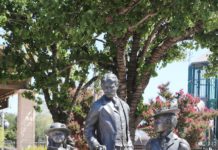Students do not shed their constitutional rights to freedom of
speech or expression at the schoolhouse gate.
Students do not shed their constitutional rights to freedom of speech or expression at the schoolhouse gate. The standard was set in 1969 in Tinker v. Des Moines Independent Community School District when the U.S. Supreme Court ruled school officials could not censor students and officials “must be able to show that (their) action was caused by something more than a mere desire to avoid the discomfort and unpleasantness that always accompany an unpopular viewpoint.”
In Dariano v. Morgan Hill Unified School District – the lawsuit filed by the parents on behalf of three students who were sent home May 5 from Live Oak High for wearing American flag T-shirts – it’s argued that the school district does not have the authority to suspend students’ rights even for one day, Cinco de Mayo in this case and that no disruption was made on campus that was associated with the students’ patriotic clothing.
The legal question, according to First Amendment scholar David Hudson Jr., is set against the backdrop of the Tinker decision: Whether the T-shirts would cause disruption or whether the school was overreacting.
On May 5, Vice Principal Miguel Rodriguez and now-retired Principal Nick Boden said the boys must leave or remove their shirts because they believed there was tension among Hispanic students and the students and that violence on campus could result.
The lawsuit claims that Boden said to the students and parents in his office that their patriotic clothing was “inappropriate” and that they could wear their American flag T-shirts “any day but that day,” according to their testimony.
Two days later, Boden apologized and said his decision was based on maintaining a safe school environment but, “In this situation, I may have moved too quickly in drawing the line of when to take preventative action,” he wrote in his apology letter.
Hudson said he believed the plaintiffs clearly had a case against the school district for violating the students’ First Amendment rights.
“Courts recognize that a healthy degree of deference is due to school officials, who have to deal with myriad student discipline issues every day,” Hudson wrote on the website of the First Amendment Center located in Nashville and Washington D.C. for whom Hudson does legal research.
Their rights, however, cannot be disregarded. If violence was reported that day related to clothing with American or Mexican themes, the school district may have had a case that the clothing was going to incite disruption.
Just as the incident invited division among some in Morgan Hill, online and on TV, not all First Amendment experts agree with the strength of the plaintiffs’ lawsuit.
Peter Scheer, the executive director of the First Amendment Coalition in San Rafael, said he wasn’t so sure the students had an open and shut case.
“Federal courts can only pursue cases in controversy,” Scheer said. The Case or Controversy Clause in Article III, Section 2 of the Constitution states that there must be an actual disagreement between parties that is capable of being resolved by the court.
“It has to be a genuine dispute between the parties and it’s not clear there is one here. The plaintiffs say the First Amendment protects my client. The defendant says, “You’re right. We won’t do it again.” So where’s the dispute?” Scheer said.
Two days after the Cinco de Mayo incident, Superintendent Wes Smith apologized publicly and said he and the district did not agree with Live Oak’s administration’s interpretation of its dress-code policy.
“If there is no live controversy anymore, there’s no basis,” Scheer said.
When asked about the Case or Controversy Clause, the students’ attorney William Becker responded that “We don’t try our cases in the press,” he said.
In Tinker, the Supreme Court ruled that Iowa public school officials overreacted when they punished students for wearing black peace armbands protesting the Vietnam War. Justice Abe Fortas warned that “undifferentiated fear or apprehension of disturbance is not enough to overcome the right to freedom of expression.”
Hudson said that most courts have ignored the “invade the rights of other” part of Tinker in favor of the substantial-disruption analysis.
“‘Invade the rights of others’ should be interpreted to mean truly trampling on people’s rights, not just simply offending someone. Otherwise, any student speech on any controversial topic could be squelched,” Hudson said.
Notable First Amendment trials and disputes
- Schenck v. United States
Supreme Court Justice Oliver Wendell Holmes stated in this 1919 case the now-famous axiom about “falsely shouting fire in a theatre.” He spelled out the “clear and present danger test” to judge whether speech is protected by the First Amendment. “The question,” he wrote, “is whether the words are used … that they will bring about the substantive evils that Congress has the right to prevent. It is a question of proximity and degree.”
- Brandenburg v. Ohio
The Supreme Court established in 1969 the modern version of the “clear and present danger” doctrine, holding that states only could restrict speech that “is directed to inciting or producing imminent lawless action, and is likely to incite or produce such action.”
- Tinker v. Des Moines Independent Community School District
In 1969, three students were expelled after they wore black armbands to school in symbolic protest of the Vietnam War. The Supreme Court ruled that students “do not shed their constitutional rights at the schoolhouse gate” and that the First Amendment protects public school students’ rights to express political and social views.
- Mozert v. Hawkins County Board of Education
In 1987, parents and students challenged the mandatory use of certain textbooks on the ground that the texts promoted values offensive to their religious beliefs. The U.S. Court of Appeals for the Sixth Circuit rejected the plaintiffs’ claim, finding that the Constitution does not require school curricula to be revised substantially in order to accommodate religious beliefs.
- Facing a lawsuit, the Edison, N.J. School Board agreed in 2003 to allow a student to wear a T-shirt that said “Whaq Iraq.” The school said it would offend students and Shaun Chichester was asked to remove it or be suspended; he complied and removed it but requested legal help shortly after. A suit was averted after the board agreed to add into its dress code a provision “recognizing students’ right to express their views in a non-disruptive manner.”
-
Palmer v. Waxahachie Independent Community School District
This case, which was appealed in January but failed, challenged the Texas school’s dress-code policy that prohibited nearly all T-shirts that donned messages, including political writings. Paul “Pete” Palmer argued to wear several message T-shirts, most notably one that read “John Edwards for President.” The courts in the Palmer case ruled that the school had merely instituted a dress code disregarding political viewpoints. Student expression wasn’t denied, the court determined, because the dress code was not basing its restrictions on content.
- The Supreme Court on March 22, 2010 refused to hear the case and backed the 9th Circuit that ruled a Washington public high school’s decision to bar a student from playing “Ave Maria” at graduation was legal. Administrators at Everett School District No. 2 told student Kathryn Nurre that she couldn’t play the hymn “Ave Maria” at her high school graduation in 2006, because it may be viewed as endorsement of religion. The conclusion said that “it is reasonable for a school official to prohibit the performance of an obviously religious piece.”
Compiled from the First Amendment Center, American Library Association








